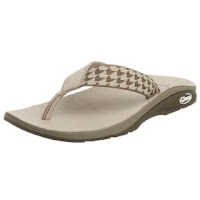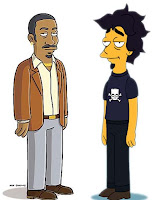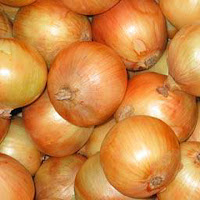 No organic onions at the supermarket? Don't cry -- it's okay to reach for the conventional ones (at least in terms of your health). Out of 44 fruits and vegetables tested, onions were found to have the least pesticide residue. But think twice before eating conventional (ie, not organic) peaches or apples. They ranked highest on the pesticide-residue list. Check out the full list here (there's also a downloadable guide, courtesy of Environmental Working Group).
No organic onions at the supermarket? Don't cry -- it's okay to reach for the conventional ones (at least in terms of your health). Out of 44 fruits and vegetables tested, onions were found to have the least pesticide residue. But think twice before eating conventional (ie, not organic) peaches or apples. They ranked highest on the pesticide-residue list. Check out the full list here (there's also a downloadable guide, courtesy of Environmental Working Group).
30 June 2008
pesticides are not so peachy
how i am spoiled
After being away for over 2 weeks, I have a greater appreciation of the kind of food I have access to. I live 2 blocks from a weekly farmer's market where I can get seasonal produce, pasture-raised beef and chicken, humanely raised pork, fresh dairy, good breads, etc. There are countless supermarkets and gourmet shops selling amazing food products. In the parts of NYC that I frequent, organic is just as accessible as conventional. I can go to restaurants that sell local, market ingredients not mystery meat from a mass distributor like Sysco. I don't have to rely on Wal-Mart for all of my shopping (more on that in a later post).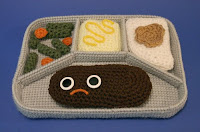 Being away from this cornucopia is eye-opening. In and around the national parks, from Wyoming to Canada, it was mostly the same menu no matter where we ate. One night we went to a place just north of Yellowstone that served trout. I asked the young waiter if it was caught locally. "Oh I don't know, it's from Sysco." That's as far as the provenance went, the largest nationwide food distributor. My boyfriend ordered something I wouldn't go near: chicken fried steak. I'm not sure you could call what was on his plate "steak," it was indeed mystery meat. Outside of Glacier, 400 miles north, we went to another place and I swear the menu was the same, barring a few personal twists. I wonder if the people living out there think about where their food comes from.
Being away from this cornucopia is eye-opening. In and around the national parks, from Wyoming to Canada, it was mostly the same menu no matter where we ate. One night we went to a place just north of Yellowstone that served trout. I asked the young waiter if it was caught locally. "Oh I don't know, it's from Sysco." That's as far as the provenance went, the largest nationwide food distributor. My boyfriend ordered something I wouldn't go near: chicken fried steak. I'm not sure you could call what was on his plate "steak," it was indeed mystery meat. Outside of Glacier, 400 miles north, we went to another place and I swear the menu was the same, barring a few personal twists. I wonder if the people living out there think about where their food comes from.
We did find a few exceptions to the homogeneous dining rule. In West Yellowstone, a cute little cafe with some Thai-inspired dishes. Even within Yellowstone itself, wild Alaskan Salmon and locally caught whitefish that's Marine Stewardship Council certified; plus fair-trade, organic coffee from Green Mountain (which my boyfriend said was delicious). On the way to Glacier, a cute little sandwich shop in a town called Ovando (pop. ~71). In St Mary's, Montana, a great little cafe with lots of vegetarian options and good local food. In Waterton, Canada, a restaurant we went back to twice just because it was rare to find well-prepared, quality food elsewhere.
West Yellowstone, a cute little cafe with some Thai-inspired dishes. Even within Yellowstone itself, wild Alaskan Salmon and locally caught whitefish that's Marine Stewardship Council certified; plus fair-trade, organic coffee from Green Mountain (which my boyfriend said was delicious). On the way to Glacier, a cute little sandwich shop in a town called Ovando (pop. ~71). In St Mary's, Montana, a great little cafe with lots of vegetarian options and good local food. In Waterton, Canada, a restaurant we went back to twice just because it was rare to find well-prepared, quality food elsewhere.
While we did find these rare gems -- in most cases at the recommendation of park rangers (don't worry, we won't mention your names!) -- they were few and far between. What I need to keep in mind is that these were seasonal places we visited. The parks aren't fully functional for most of the year. They get most of their visitors from July to August with some coming in mid-June and September. And I'm sure most folks who live out there don't eat out that often -- if they do I'd hope there are some local hidden gems the tourists don't know about yet. Somehow, I doubt it.
27 June 2008
interspecies love, or at least friendship
As I've said a few times before, I freakin' love animals. And I love it when animals of different species love each other. Like the story about the baby hippo orphaned by the tsunami who befriended an old tortoise. Or this story about the dog and sheep who have a special relationship (purely platonic, of course). There's a whole blog dedicated to this stuff.
While in Yellowstone, we went on a guided horseback ride through an area of the park where over 100 elk had just settled for late spring (before heading up to the cooler mountainous regions for summer). The stablehands had just told us that they had only arrived two days prior to our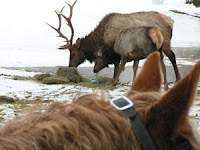 being there. They also told us that the horses and elk get along really well. When we went on the ride, we spotted the elk or rather they spotted the horses and us. There were so many. They were gorgeous. But if it weren't for one of the guides we were with, the elk would have come right up to the horses, and the horses would have forgotten all about us. So the guide did her best to corral the elk. It was an amazing sight. These beautiful creatures all herded together, signaling to each other in their eerie high-pitched calls. Unfortunately, we couldn't take any pictures on the ride because if anyone dropped their camera it would spook the horses. (Image above is borrowed.)
being there. They also told us that the horses and elk get along really well. When we went on the ride, we spotted the elk or rather they spotted the horses and us. There were so many. They were gorgeous. But if it weren't for one of the guides we were with, the elk would have come right up to the horses, and the horses would have forgotten all about us. So the guide did her best to corral the elk. It was an amazing sight. These beautiful creatures all herded together, signaling to each other in their eerie high-pitched calls. Unfortunately, we couldn't take any pictures on the ride because if anyone dropped their camera it would spook the horses. (Image above is borrowed.)
In Waterton, Canada (the northern counterpart of Glacier National Park, Montana), I witnessed what could have been another instance of interspecies love. A bighorn sheep and a mule deer sharing a shady spot in the grass. I can't be too sure about their relationship, but sheep usually hang out with their kind. Maybe this one was excommunicated? The mule deer in Waterton are very acclimated to humans, and are everywhere munching on people's lawns all day long. Did this mule deer feel sorry for this sheep, who only had one horn, or was she merely tolerating him?
I'll never know for sure.
26 June 2008
the dirt on cleanliness
 I'm not a germaphobe, but I know plenty of people who are. And producers of antibacterial soaps and chlorine bleach like to perpetuate the fears that these people have about dirtiness. Unfortunately, the chemicals that make these products "effective" can be harmful to your health.
I'm not a germaphobe, but I know plenty of people who are. And producers of antibacterial soaps and chlorine bleach like to perpetuate the fears that these people have about dirtiness. Unfortunately, the chemicals that make these products "effective" can be harmful to your health.
Take triclosan, for example. This compound has been added to a lot of products in the last few years, from dish soap to toothpaste (treehugger has a good list here). Triclosan is not only a suspected carcinogen, it also can lead to antibacterial resistance. Just like with some antibiotics, antibacterials like triclosan and triclocarban work in a specific way to kill off bacteria. Over time, the bacteria mutate and become immune to the compounds. This has been demonstrated in a study examining triclosan's effect on bacteria such as resistant E coli.
Some believe that a slightly dirty home environment is better for one's immune system than a super clean home. There have even been studies linking overly hygienic environments to the development of allergies. And one study in rats helps support this "hygiene hypothesis."
So what does one do to stay clean in an unclean world?
Good old soap and water is just as effective as antibacterials.
Here are some recommendations:
- For the hands and body, I love Dr. Bronner's liquid soap (there's also a bar version)
- For the dishes, Seventh Generation and Ultra Citradish
- For the teeth, Tom's of Maine
- In place of chlorine bleach, Seventh Generation peroxide-based bleach
- CleanWell Natural Hand Sanitizer
- EO Organic Lavender Hand Spray
- Clean George in a bunch of scents
25 June 2008
amazing trip
There's so much to say about my travels, including all of the eco-analyzing I did while on the trip. We went from Yellowstone to Glacier to Waterton (in Canada) within 10 days. Saw so much wildlife, mountain ranges, lakes and streams, geothermal activity, and plant life. Such vast open spaces, both in the parks and out. In the next week, I'll be posting all of the goods, from the food we ate to the greenwashing we saw all around (and some genuine eco-efforts as well).
If you've ever thought about visiting this part of the country, I think this was the best time of year to do it (late June). It's an amazing and unforgettable experience.
Of course, the pictures ain't nothin' like the real thing, but you'll get the idea.
12 June 2008
before i go

No one will be home to watch Letterman or to update the Netflix queue. There won't be anyone looking for a late night snack in the fridge or listening to iTunes on the stereo. The only life stirring (very slowly) will be the plants, unless our little mouse friend returns in our absence.
So there are a few things we need to do before we leave for vacation:
- Hold the mail
- Stop the weekend paper
- Unplug everything (powerstrips make this easier, at least until the whole house switch is available)
- Eat all the perishables in the fridge (this can require careful planning)
- Water the plants
- Close the windows
- Turn down the thermostat (in winter), turn off the A/C (in summer)
- Give the keys to a responsible friend
waste less
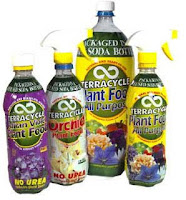
This is a great idea: no waste. One company out to rid the world of trash is TerraCycle. They're using your old cookie wrappers, soda bottles, drink pouches, etc. to package their plant food products. Check it out.
clotheshorse eco-conscience
 You know the era of conspicuous consumption is at risk of collapse when even the well-to-do are trawling consignment shops, albeit for designer goods. Here, Ruth La Ferla of the NY Times profiles the current prosperity of second-hand boutiques, such as Ina in NYC, and the fall of full-price fashion.
You know the era of conspicuous consumption is at risk of collapse when even the well-to-do are trawling consignment shops, albeit for designer goods. Here, Ruth La Ferla of the NY Times profiles the current prosperity of second-hand boutiques, such as Ina in NYC, and the fall of full-price fashion.
11 June 2008
off to commune with nature
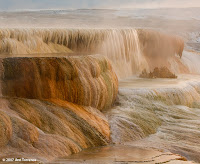 Air travel is probably my biggest eco-vice. But I can't help it. I love to travel to far-off places. Last year it was Italy (for vacation), South Africa (tagging along with my boyfriend on a work trip), and LA (another work trip). This year it's Yellowstone and Glacier National Parks. How can one resist the natural splendor of our last great wilderness? And as I've mentioned before, I'm a sucker for animals -- I can't wait to have an encounter with some wild creatures, from a distance at least (a bit scared about the grizzlies and wildcats!)
Air travel is probably my biggest eco-vice. But I can't help it. I love to travel to far-off places. Last year it was Italy (for vacation), South Africa (tagging along with my boyfriend on a work trip), and LA (another work trip). This year it's Yellowstone and Glacier National Parks. How can one resist the natural splendor of our last great wilderness? And as I've mentioned before, I'm a sucker for animals -- I can't wait to have an encounter with some wild creatures, from a distance at least (a bit scared about the grizzlies and wildcats!)
We also needed to rent a car on this trip, to get us through the parks and go from one to the next. When I did my search for rental cars, I imagined we'd get some economical compact sedan, like a Ford Focus or something. I even had high hopes for a hybrid. None of these notions manifested in real life. Instead it was either a $3,500 pick-your-car rental, or a $1,400 SUV. And not just any SUV, a big-ass Chevy Suburban. Could it get any worse? I think I'll start crying in the rental agency when they hand over the keys. And I'll cry on the inside through the whole trip. How contradictory the whole debacle is, to enjoy the preservation of natural places while simultaneously mucking them up.
So what does one do to lessen their impact on a trip such as this? Of course there's carbon offsetting for the flight and SUV. And there are other no-brainers:
- Bringing out what we bring in, not leaving a string of Clif bar wrappers on the trail
- Sticking to the paths, not traipsing all over some endangered wildflowers or a marmot hole

- When nature calls, we'll do our business at least 200 feet from a waterway, bury the unmentionables, and use natural TP (watch out for the poison oak!) (It's also recommended to carry out TP in a resealable plastic bag)
- We won't be camping or bathing outdoors, but if that were the case we'd use biodegradable soap like Campsuds 200 feet from a water source (or you can take the stance of this person who uses no products at all while camping)
- US Scouting Service
- Backwoods Ethics by Laura and Guy Waterman
living off the health of the land
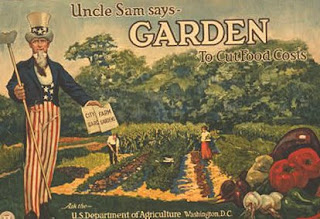
I'm a fan of Mark Bittman, the NY Times columnist, foodie, and minimalist chef. I'm even more enamored now that he's written about some practical advice about eating less meat. Without getting all political or ideological, he offers some easy tips on incorporating more healthy veggies and alternatives to meat in your meals. Here it is in today's Dining and Wine section of the Times.
Also in the Times, an answer to those who eschew organic because of the price: plant your own! That is if you've got the land, of course. Most of us city dwellers don't have the luxury of a patch of earth to dig into. But there are community gardens, if you're feeling so ambitious. If you do decide to start your own victory garden, you'll have to do some research. Here are some sources for organic vegetable gardening:
- Organic Garden Tips
- The Helpful Gardener
- Or subscribe to a magazine like Permaculture (save paper: they have an online subscription, too)
survive the summer swelter: part 2
 Part 2 in a two-part series on how to handle the heat of summer. Catch part 1 here.
Part 2 in a two-part series on how to handle the heat of summer. Catch part 1 here.
keep your cool
- Get into some responsible swimwear and hit the beach (Don't live near a body of water? Build a natural pool)
- Meadow bikini made from repurposed Lycra (from BTC elements, pictured right)
- Amanda bathing suit by Kelly B made with organic cotton
- Loomstate mens' board shorts
- Wetsuits made with responsible fabrics from Patagonia
- Wear lightweight fabrics
- Slip on some flip-flops
- Patagonia for men
- Chaco for women (partially made with recycled rubber)
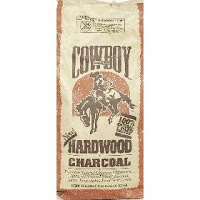
- Find pasture-raised meats in your neck of the woods on Eat Wild's database
- Find greenmarkets, CSAs, and more on localharvest.org
- BBQ with Cowboy Charcoal, a no-chemical charcoal
- Which is least impactful on the environment? Propane or charcoal? The debate continues
- More on my experiences with BBQ meat here
- Drink organic beers like Wolaver's, Eel River IPA, or one from Peak Brewing Co.
- Burt's Bees Herbal Insect Repellent
- JASON Quit Bugging Me (that's what I used to say to my brother growing up)
And you can carry all your summer essentials in this cute Organic Cotton Tote
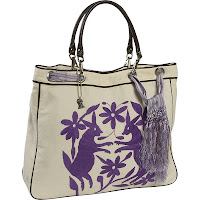
Happy and Healthy Summer!
10 June 2008
a greener h&m?
One of my favorite shops (before I boycott big chain stores) was H&M. Back in 2000 when I heard Hennes & Mauritz were making their US debut, I wrote to the company to find out the exact date. I remembered how great it was -- while spending the semester in London, a typical student, with holes in my pockets and moths sprouting from my wallet -- to discover clothes both adorable and affordable.
But then about a year ago my consumer conscience woke up.
So after reading the headline that H&M were to introduce more organic cotton into their clothing, I got a bit excited. Until I read the rest of the story. Check out the full story about H&M's enviro-responsibility, artfully broken down here. Looks like I'll have to hold off my return for a later date.
airing the dirty laundry
 One of the easiest ways to move toward a more eco-friendly lifestyle is by changing the way you do laundry. And one of the first things I did was make the switch to biodegradable, petroleum-free laundry detergent, like Seventh Generation.
One of the easiest ways to move toward a more eco-friendly lifestyle is by changing the way you do laundry. And one of the first things I did was make the switch to biodegradable, petroleum-free laundry detergent, like Seventh Generation.
Here are some other low-impact laundry tactics:
- Washing clothes in cold water not only saves energy (in heating the water), it helps preserve the colors and fabrics over time
- Air drying clothes also saves tons of energy. Try one of these contraptions:
- Opting for CO2 cleaning instead of traditional dry cleaning is safer for you and the environment. Find CO2 cleaners in your area

- Handwashing with a non-toxic detergent is also a great alternative for your delicates like cashmere and wool
- The Laundress Wool & Cashmere Shampoo leaves sweaters soft and smelling nice without chemical residue
- Replacing an old washer and/or dryer also saves energy. Be sure to get one with an Energy Star rating
Check out this new washing machine from the UK that uses only 1 cup of water for a load of wash. Though it does require all these little plastic chips to do the cleaning (good for about 100 washes). What would you do with them when they need replacing? Got any ideas?
more about the market
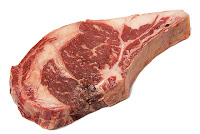 Fresh/local produce, fresh air, personal interactions with the farmers and producers of your food, and now another reason to love the greenmarket: good quality, pasture-raised & fed meats!
Fresh/local produce, fresh air, personal interactions with the farmers and producers of your food, and now another reason to love the greenmarket: good quality, pasture-raised & fed meats!
NY Mag does a rundown of the carnivorous offerings at the city's farmers markets here.
(Image: Grazin' Angus Acres Farm rib steak by Stewart Isbell, courtesy of NY mag)
survive the summer swelter: part 1
It's not even summer yet and it's in the high 90s along the Eastern Seaboard. What does one need to do to get by in this heat?
block the sun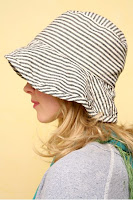
- Keep your skin protected without nasty chemicals or oxybenzone (which has been linked to cancer) with these safe sunscreens:
- Use a hat to keep the harmful rays off your head and face
- For baby (organic & fair trade)

stay hydrated
- Make sure you've got your water with you in one of these reusable beauties:
- Klean Kanteen
- Sigg (they've got a new hot/cold version to keep that water cold in the summer heat)
Stay tuned for Part 2 of survive the summer swelter with tips on how to keep your cool, eat well, and fight off the bugs...
09 June 2008
organic music?
It's unplugged. It brings people together. It feels good!
Like it? Check out the New York Times feature about Hypnotic Brass Ensemble here.
the art of resistance
About a year ago, I stopped visiting my favorite shoe store. Yes, like an old friend I would occasionally drop by, admire the new merchandise, try on a pair or two, then maybe walk out with some nice new boots or sandals.
The store would reward me for my purchases with little discount cards, you know, the ones that have a place to punch holes indicating how much you've spent, and once you accrue a certain amount, you get a 10% discount on your next purchase. I always carried these little cards with me because it was rather likely I'd cross paths with one of the many branches of this store on my way to or from somewhere.
The shoes there were always well made, mostly in Italy. This is why I shopped there. I had already decided not to buy shoes made in China, and had reasoned that Italy was closer to the US and had fewer environmental violations (which is truly not the case!). Then the day came, like it does for many makers of fine goods, that this store started selling more shoes made in China, or they'd be labeled with an ambiguous "Made in Europe" stamp. I'd see a shoe I'd like and have to put it back. It's sad to say, this was hard for me.
One day, I decided to call it quits. I gave my friends all of the discount cards I had amassed. I had officially broken up with my favorite shoe store. Sometimes, though, I'd peak in the window, just to see how my old pal was doing, to see what new styles were on display. Just the other day, Saturday to be exact, I walked by one of these stores and was tempted by some really cute sandals in the window. It was difficult, but I just walked on by.
Resisting the impulse isn't easy. It's like responding to a hunger, a craving. But resisting an urge can lead to the discovery of something new. So when I recognize the pang of desire for material things, I make alternative plans. Instead of stepping foot in the store, I'll make a bee line straight for the nearest park, go to a museum, or go to a coffee shop to have a cup of tea. Feed your brain with other things. This is what I remind myself when the urge to splurge arises.
More on the financial implications of impulse buying and what you can do to stop it here.
08 June 2008
father's day gift guide
You wouldn't buy Dad another tie, or a t-shirt that says "World's Best Dad" on it for Father's Day, would you? I didn't think so. Well, if you need some help picking out a little something special for Pops for his special day, there's still time. Here are some ideas with every budget in mind:
- Gift subscription to the Green Guide. Opt for the downloadable version for an even greener gift ($15 paper version, $12 online version).
- The Kindle -- yeah, it's an electronic device, but it saves tons of paper. Dad can download books, magazines, newspapers, and even blogs ($359).
- If Dad's not techy, or just likes the old-fashioned printed word, get him a used or rare book from Alibris.
- Adopt an endangered animal, like the gray wolf (for as little as $20).
- Outdoor fire pit set made of a repurposed steel drum and utilizing clean-burning logs from VivaTerra ($259).
- Succulent garden -- an indoor mini garden that doesn't require a lot of water or care. Or you can make a succulent terraria yourself ($89 or cheaper if you DIY).
- Get him a class, like cooking or wine tasting. Or if he's more adventurous, surfing (prices range).
- Give him an experience, like a hot air balloon ride (commentary on the environmental
 impact here).
impact here). - Classic shaving kit with straight razor. Make sure the razor is made with good quality carbon steel, like this one (you can also get a cheaper, vintage one on ebay). Be sure to include shaving soap, brush, and strop (vegan options here). How to use one and a comparison of various shaving methods from Mother Earth News here.
For other holidays, encourage your friends and family to sign up for an alternative registry, where recipients can request gifts ranging from meaningful experiences to specific items that aren't necessarily available in department stores.
a little visitor
 Last night as we sat down to watch "The Jerk," my boyfriend saw something out of the corner of his eye. "I think I saw a waterbug or something," he declares. I tense up a bit. I don't mind little creatures, and in fact, when they're in their natural habitat I admire them in fascination. But when one of these creatures finds his way into my home, I freak.
Last night as we sat down to watch "The Jerk," my boyfriend saw something out of the corner of his eye. "I think I saw a waterbug or something," he declares. I tense up a bit. I don't mind little creatures, and in fact, when they're in their natural habitat I admire them in fascination. But when one of these creatures finds his way into my home, I freak.
"Oh, there he is," a pause as he points behind the TV stand, "I think it's a mouse." Oh man. I don't like this. A look of disapproval comes my way, maybe because at this point I'm standing on the couch. Okay, I need to buck up and shake this irrational fear.
"He's so tiny... he's kind of cute," he says reassuringly. In the 8 years he's lived in this apartment -- and the 5 or so years that I've been here -- this is a first. We've been pretty lucky to have had so few parasitic visitors. Maybe a cockroach or two. That's it.
So on and off for about an hour or two (between snippets of "The Jerk") it goes like this: my boyfriend tries to scare the little bugger out from behind the TV stand. I, with big cardboard box in hand, eyes like a hawk, peer from my perch (the couch) waiting to pounce. My boyfriend shines a flashlight to expose him dangling from the TV wires, his shadow looming large on the wall. The mouse climbs onto the shelf where the DVD player and stereo live. Then he climbs down the wires and hides under the stand. Again, he runs up the wires. And on and on. Finally, makes a break for it. My weak attempt to toss the box over him is thwarted. He's now safe in the underbellies of the stove.
Weary and bleary eyed, we block him in the kitchen using a big mirror and steel wool and go to bed. To keep him from our bedroom, just in case, we stuff a towel under the door.
In the morning we assess the situation. He's nowhere to be found. I do some research on humane trapping. I'm not about to kill the little guy. I have to admit, the wily bastard is cute. And I don't want to come home to find a dead mouse belly up in a snap trap or worse, stuck in a glue trap.
So I found two methods for trapping, both DIY. We're trying this method from Chris Glass, who says it worked within an hour. There's also another method, using a 2-liter plastic bottle, but it's a bit more time consuming to construct.
(Left: Our version of the humane mouse trap)
Stay tuned...
07 June 2008
farmer's market alert!
06 June 2008
clearing up the fish fog
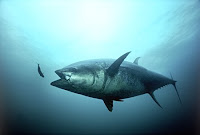 Trying to figure out which fish are okay to eat can be tricky. So many questions enter my mind when attempting to decide on the fish I'll consume. Does the fish I'm about to eat contain mercury? Is it overfished? Is there trawling involved, which damages the sea floor? Are other sea creatures getting unintentionally trapped in the nets?
Trying to figure out which fish are okay to eat can be tricky. So many questions enter my mind when attempting to decide on the fish I'll consume. Does the fish I'm about to eat contain mercury? Is it overfished? Is there trawling involved, which damages the sea floor? Are other sea creatures getting unintentionally trapped in the nets?
One little tool which helps in the decision process is the handy Monterey Bay Aquarium fish card I carry around with me. On their Seafood Watch site, you can order a free pocket fish card of your own (or more for friends, if you'd like) or just print one out for your particular region. They break it down simply: Best Choices, Good Alternatives, and Avoid. If you're curious about a particular fish, you can also search their online database.
And if you're really curious, they're hosting a webcast next Friday, June 13th where they'll talk about how to cook and eat the fish that are sustainable and how you can be an advocate for our oceans.
fair trade organic love
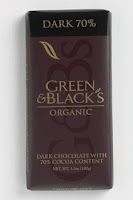 Chocolate is love. Am I wrong? I mean, scientists even say so. And has anyone ever read the book or seen the film Chocolat? (hello, Johnny Depp is in it!)
Chocolate is love. Am I wrong? I mean, scientists even say so. And has anyone ever read the book or seen the film Chocolat? (hello, Johnny Depp is in it!)
Chocolate is especially great if it has no baggage. When I get the craving, I try to reach for fair trade and organic chocolate -- like Green & Black's.
I just whipped up a batch of dark chocolate cupcakes, using the 70% dark variety of G&B's. It's my secret weapon for any chocolate fix. The recipe is at America's Test Kitchen (you have to sign up for the free newsletter to get it). And don't forget the dark chocolate butter cream icing. It's easy to make this whole recipe organic. Just swap out conventional ingredients like flour, sugar, and butter for organic.
You can get Green & Black's at your local supermarket, specialty store, or on Amazon.
And here are some more fair trade organic chocolates:
Dagoba
Endangered Species
05 June 2008
the solution is simple
 Alain Robert (aka The French Spiderman) and Brooklynite Renaldo Clarke scaled the New York Times building today for related causes: Robert, in honor of World Environment Day (and against global warming) and Clarke for Malaria No More. Each of the men donned t-shirts promoting the causes. According to The Solution Is Simple (Robert's cause), global warming kills more people than 9/11 every week. They were both arrested for their actions. Check out the slide show on NYT. (Photo by Lucas Jackson, Reuters)
Alain Robert (aka The French Spiderman) and Brooklynite Renaldo Clarke scaled the New York Times building today for related causes: Robert, in honor of World Environment Day (and against global warming) and Clarke for Malaria No More. Each of the men donned t-shirts promoting the causes. According to The Solution Is Simple (Robert's cause), global warming kills more people than 9/11 every week. They were both arrested for their actions. Check out the slide show on NYT. (Photo by Lucas Jackson, Reuters)
locavores, log in!
 When I can't get to my local farmer's market on Saturdays, I get a little cranky. It means I won't have access to local produce until the following week, so I have to resort to the fruits and veggies at the supermarket which are shipped in from California, Canada, Mexico, or even New Zealand (though I try to find the stuff that's grown closest to home, if possible).
When I can't get to my local farmer's market on Saturdays, I get a little cranky. It means I won't have access to local produce until the following week, so I have to resort to the fruits and veggies at the supermarket which are shipped in from California, Canada, Mexico, or even New Zealand (though I try to find the stuff that's grown closest to home, if possible).
I wanted to join a local CSA (community supported agriculture), but the ones in my area are all booked up for the year.
But wait, what's this? An article from the New York Times telling me I can just get on the ol' interweb to get my local produce fix? I can't help but picture Farmer Bob sitting on his tractor, MacBook in lap, waiting to fulfill orders from urbanites such as myself. But I guess it makes sense, in an age where lots of people get their groceries delivered via Fresh Direct and other such services.
These local-food-via-internet distributors are sproutin' up all over the country. There's Spud on the West Coast. And Natural Direct in Illinois. In Texas, there's Greenling. And right here in NYC, there's Urban Organic. There's also My Personal Farmers, which serves parts of NY state (like Westchester) and CT.
What they provide you with is a weekly delivery of fresh farm products, the season determines what goes in it, you determine the amount delivered, based on the size of your household. Some of the services also provide meat, dairy, and other products like honey. They also offer up recipes tailored to what's in your basket for a given week.
The one thing I'd miss is actually picking out the goods myself, and being able to talk to the farmers directly like I do at the farmer's market. But at least I'd know I'm supporting local agriculture, which means fresher, more nutritious produce; less carbon burnt; keeping family farms in business (as opposed to supporting agribusiness); and sustaining the local economy.
eco vans
A little over a year ago, I stopped buying apparel made in China. There are numerous reasons, but it was mainly an environmentally driven decision. But I've found that I've needed to make a few exceptions, and in those cases, my decisions were also environmentally driven.
Like the clothing company Nau, who sadly is closing up shop. Their efforts to run a sustainable business using materials that were either recycled or organic or just responsibly sourced were inspiring. Their designs and attention to detail were impeccable. And they gave a portion of sales profits to the charity of your choice. But a lot of their clothes were made in China, Thailand, and other Eastern countries. Sometimes ya gotta bend the rules, even your own.
It's also really hard to find shoes that aren't made overseas. Again, one needs to make exceptions. Luckily, companies like Vans are starting to make their shoes out of sustainable materials. You can get the classic slip-on which has hemp infused gum rubber outsoles and water-based glues and inks to make them a bit more eco-friendly. They also make vegan shoes without any animal products.
Here are some other companies making responsible kicks:
simple
terra plana
keen
patagonia
beyond skin
5 actions you can take right now
1. Slow global warming: Urge your senators to push for clean energy
2. Protect children from airborne lead with stricter EPA standards
3. Stop mountaintop removal coal mining
4. Save Yellowstone and The Greater Rockies from coal mining
5. Stop the clock on species extinction
The endangered Philippine eagle
Mountaintop removal coal mine in WV
(Vivian Stockman)
afternoon web scan
- Urban farming: There Will Be Chicken Blood [Slate]
- Get More From Milk: Pasture-fed, Organic Is More Nutritious [OCA]
- Food Is a Growing Commodity [NYT]
- Arnie Down Under (via satellite) for World Environment Day [NZ Herald]
- More From the Governator: Drought Declared in Cali [NYT]
- Coca-cola India to Conserve Water (but I ask, what about the GMO corn syrup?) [Times of India]
- Jane Goodall: Please Do What You Can To Save Mother Nature [China View]
Happy World Environment Day!
how much good would good wood do?
One of the biggest contributors to climate change is deforestation. And if we don't pay attention to the labeling on things like paper products (tp, napkins, stationery), building materials, or furniture, we won't know if we're contributing, too.
When my boyfriend and I were renovating our kitchen last year, one of my criteria for cabinets was that they be made from FSC-certified wood (The Forest Stewardship Council is an independent organization that certifies if manufacturers of tree-based products are sourcing materials from sustainably managed forests). We did some initial shopping at big box stores like Lowe's and Home Depot. When I'd ask the sales people if they had any cabinets available in FSC-certified wood, they didn't know what the heck I was talking about. So we had to do some research.
They're not only responsibly made, they look really great, too.
When buying any wood or paper products, look for the FSC seal.
Pledge to buy good wood here.
04 June 2008
eco to go
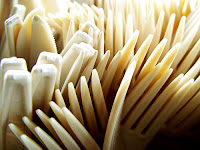 Sick of the piles of disposable utensils and napkins that come with your takeout orders? Well thankfully, someone is speaking up against all that waste. A new movement started in NYC by ecoagents* is spreading the word to restaurants, that, well, some people don't need or want those plastic forks wrapped in cellophane. It's called eco to go and I hope it catches on. When you call to place your order, just say "eco to go" and they'll omit all the extra stuff you don't need. Find participating restaurants here: eco to go via ideal bite.
Sick of the piles of disposable utensils and napkins that come with your takeout orders? Well thankfully, someone is speaking up against all that waste. A new movement started in NYC by ecoagents* is spreading the word to restaurants, that, well, some people don't need or want those plastic forks wrapped in cellophane. It's called eco to go and I hope it catches on. When you call to place your order, just say "eco to go" and they'll omit all the extra stuff you don't need. Find participating restaurants here: eco to go via ideal bite.
*Ecoagents is a non-profit working to protect the Amazon Rainforest and empower the indigenous communities to sustain their way of life and their native environment.
turning green
These days, everyone's going green. Even political pundits. Check out the Huffington Post's new blog here.
5 eco-minded books on my shelf
Silent Spring, Rachel Carson
The Botany of Desire, Michael Pollan
Collapse, Jared Diamond
Big Green Purse, Diane MacEachern
The World Without Us, Alan Weisman
03 June 2008
what's that smell?

Oh, it's me. I switched to deodorant that doesn't contain all the baddies (chiefly: aluminum, a heavy metal that's absorbed through the skin and has been linked to Alzheimer's, though this is a controversial point). And usually, the Weleda deodorant spray I use works. Really. But I recently changed from the Rose scented version to the Citrus. Old rosey was more reliable. Which is sad because I wanted a fresh citrus scent for summer. Guess I'll just have to carry it around with me all day and reapply. Or just deal with my own natural scent.
The fragrance,You can get Weleda Deodorant Spray here:
my friend, that floats
to you this moment
streams from the tent
of the secrets of God.
--Rumi
Amazon
Drugstore
Weleda's own site
PS. My man wears the sage-scented version and it smells pretty good. And he doesn't stink at all.
kaight is great
There was a time when if you said to someone that a clothing item was made of sustainable fabric you'd either get a blank stare or they'd imagine a burlap-like sack made of hemp. This, thankfully, is no longer the case.
One of my favorite places to shop for great-looking clothes made of sustainable materials is Kaight. The sort-of-eponymous shop owner, Kate, is so friendly and helpful. And she's got great taste in clothing. I get my haircut in the neighborhood and can't resist stopping there on my way home. I'm the type who, as you may have gathered, prefers buying a small number of quality goods over piles of whatever is the latest and cheapest trend. So here are a few of the items I've brought home with me from Kaight (most of them, on sale):

Prairie Underground organic cotton dress (above left, in periwinkle, not cranberry)
Viridis Luxe bamboo dress (above right, in black, not yellow)
Linda Loudermilk silk tuxedo dress
John Patrick Organic cashmere sweater dress
I also got a pair of black organic cotton leggings from Jaime Pressly's (yes the same from My Name Is Earl) clothing line J'aime.
If you're lucky enough to be in NYC to visit the shop, it's at 83 Orchard St (btwn Grand and Broome). If not, you can get a taste online.
02 June 2008
love animals, hate sprawl
If you don't already know this about me, I'm about to let you in on something: I'm a sucker for animals. There really isn't an animal I don't like. Even the ugliest, most bizarre creatures are fascinating to me. And the thought of actually communing with animals, on say my own piece of property, is -- while a bit intimidating -- very exciting.
Well there's a community out in Nevada, outside of Reno, where people live on little patches of land (around 1 acre or more) with their animals. These aren't farms and this isn't really rural country. It's where suburban sprawl meets the good ol' days when it was commonplace to have livestock in the backyard. Even my dad grew up with chickens in the yard -- in Hackensack, New Jersey.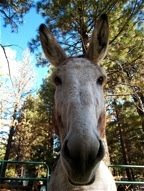 So these people out in Golden Valley, NV, have horses, goats, chickens... and, yes, even donkeys. But now that the landscape is leaning toward suburbanization, their agricultural lifestyles may be threatened.
So these people out in Golden Valley, NV, have horses, goats, chickens... and, yes, even donkeys. But now that the landscape is leaning toward suburbanization, their agricultural lifestyles may be threatened.
Sadly, one of these happy agrarian households was recently broken up. Seems the neighbor couldn't take the braying of the donkey any longer. I can understand that. The guy couldn't sleep because the donkey would bray in the middle of the night. But didn't this guy realize he was moving next door to someone who had livestock in their yard? Wouldn't you do a little research on the culture of a neighborhood before moving in?
The case went to court and despite a reasonable defense and much community support, the judge sided with the complainant. The community, outraged and fearful this case would set a precedent, sought that a stipulation be added to new home contracts in their town. Now, anyone new to the neighborhood will be forewarned. But who reads the fine print? And sadly, this may not protect the citizens from future litigation.
Check out the full story, plus interactive features, here.
save the planet: eat pb&j
To balance out the previous post about meat products, here's an ode to the peanut butter and jelly sandwich.
There's no dairy in your butter,
no meat in your jelly;
Oh, PB&J,
get into my belly!
Alright, I'm no ee cummings or Samuel Taylor Coleridge. But I do have an appreciation for this vegan-friendly sandwich. The PB&J is a near-perfect embodiment of the sustainable meal (if you wash it down with a glass of organic non-GMO soy milk, that is). And who doesn't like PB&J? (ok, except those with nut allergies.) Everyone has their preference. Skippy or Jif with grape jelly on Wonder Bread with the crusts cut off? Well that's not for me, but that may be what we all remember eating as kids.
This is how I like mine. First off, I call it an AB&J. Almond butter takes the place of peanut butter, probably more for health reasons -- the fat in almonds is healthier than in peanuts -- though the toasty almond taste is quite delicious. Usually, strawberry preserves represent the "J," so I guess I should really call it an AB&P. Then it goes on some kind of healthy whole grain bread, right now I'm liking Healthy Hemp Bread from French Meadow Bakery. It's full of protein and yummy seeds and stuff, and it toasts really well.
To find out more about how PB&J can save the world, check out the PB&J Campaign. They're trying to spread the message that replacing meat-based meals with PB&J (or any vegetarian or vegan dish) significantly reduces your carbon footprint. And if you're feeling so inclined, take the PB&J pledge. It's a simple step you can take to leave the world a better place.
my own private omnivore's dilemma
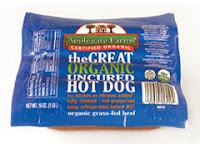
It can be tough being an omnivore these days -- but it's not hopeless. Even before reading Michael Pollan's The Omnivore's Dilemma, I considered the impact of my culinary choices and thought of myself as a responsible eater. Buying from the farmer's market when I could, buying organic as much as possible, eating what I thought was meat from humanely treated animals (it's not always so easy to tell, sometimes you've got to take a leap of faith).
But since reading the book, I've made another change to my diet. I'm only eating grass-fed beef. If you don't plan on reading the book, trust me, grass-fed is not only healthier, it's easier on the animal (they really can't digest corn, which is what they're fed the bulk of their penned-up lives), and the environment -- especially if the beeves (yes, in farmer's parlance that's plural for beef) are pasture fed.
So this past Saturday my boyfriend and I went to a BBQ and brought our own hot dogs to accommodate for this new eating choice (see above). They were Applegate Farms Organic Grass-fed Hot Dogs (can't ya just picture pastures full of hot dogs grazing on grass?), and they were pretty damn tasty. We got them at our local Fairway supermarket. They may be available at your local grocer. You can also buy 'em on their site.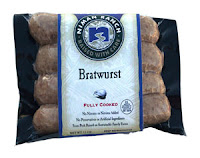 On to a different animal. The pig. I love pigs. They're so cute, and so tasty! (Sorry to the vegetarians reading this post. I think I felt a collective cringe and sigh from you.) I don't eat pork that often, but when I do, I'd prefer one that's had a relatively happy life. So we turn to Niman Ranch for their quality products. And they're pork bratwursts are even more delicious than the aforementioned hot dogs. A slight spicy bite from the ginger and spices, and like they say on their site, they're great on a roll with mustard.
On to a different animal. The pig. I love pigs. They're so cute, and so tasty! (Sorry to the vegetarians reading this post. I think I felt a collective cringe and sigh from you.) I don't eat pork that often, but when I do, I'd prefer one that's had a relatively happy life. So we turn to Niman Ranch for their quality products. And they're pork bratwursts are even more delicious than the aforementioned hot dogs. A slight spicy bite from the ginger and spices, and like they say on their site, they're great on a roll with mustard.
You can get Niman Ranch products on their site, and sometimes on Amazon. You might be able to get them at your local Whole Foods or other supermarkets. And if you live in NYC, they're available at Fairway.
01 June 2008
buying less, living more
Ok, ya got me. This is a blog about things you can buy, which seems a bit contradictory to what I'm gonna say here. Buying less stuff is really one of the best things we can do for ourselves and the planet.
A few years ago while waiting in line for the dressing room at H&M, with multiple hangers leaving impressions on my tired fingers, a little voice came into my head and asked, "do you really need this $39.99 sweater made in Sri Lanka? or this dress made of who-knows-what material in the Philippines?" Then this happened: I started putting everything back on the racks. I walked out of the store, empty handed. This was the start of something big.
This is when my consumer's conscience woke up. I first started by reading labels. If something was made in China, I put it right back. I turned over every shoe, peered under every dress, searching for its provenance. I finally figured out that most stores I enjoyed shopping in -- Anthropologie, Club Monaco, Old Navy, even higher-end shops like Barney's Co-op -- all sold apparel made in far off lands. If on the rare occasion something was made in the good ol' USA, I gave a little cheer.
I've since sworn off these stores, and as a result have cut back significantly on my consumption. No more lunch hour shopping sprees at whichever store happened to be a few blocks away from the office. No more retail therapy. And a funny thing happened. Walking away from these old habits made me feel good. Letting the urge to shop pass was actually rewarding, not just for my bank account but for my psyche.
Of course I still buy clothing, but I don't do it based on the latest trends or sale at the nearest store. I try to buy mostly vintage, mostly made in the USA, or something made with sustainable materials (like organic cotton). I've even found some cool free clothes from fun events like the Swap-o-ramarama. I've discovered so many more interesting and unique things this way. I don't really need to worry about seeing someone out in the same dress. And since I'm not worrying about things like that anymore, I have more time to think about the important things... like what to share with you in my next post.

